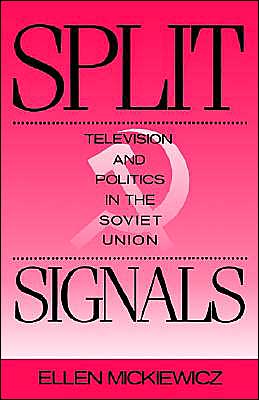

 |

|

Sold Out
Book Categories |
Television has changed dramatically in the Soviet Union. In 1960, only five percent of the population had access to TV, but by 1986, fully 93 percent were viewers, across a vast land mass stretching over eleven time zones. It is now the main source of information in the USSR, and as Ellen Mickiewicz points out, television has become Mikhail Gorbachev's most powerful instrument to pave the way for change in the economy, the political system, the educational system—in short, in the way that the Soviet people relate to society and the state.
In this wide-ranging, vividly written volume, Mickiewicz compares over 100 hours of Soviet and American television, covering programs broadcast during both the Chernenko and Gorbachev governments. She describes the enormous popularity of news programs—the main such broadcast, Vremya (Time), is watched by 150 million viewers nightly, or over 80 percent of the adult population—and discusses how Soviet jounalists work in the United States, how they understand us, what sources they rely on, and what they think of our coverage of them. Mickiewicz offers a fascinating description of the world seen on Soviet TV. For instance, Soviet viewers see much more international news than American viewers, and this news tends to focus on the West, with less coverage of Communist Bloc countries and the Third World. Political violence and protest marches dominate the news, stressing capitalist unrest and the overall responsibility of the United States. But perhaps most interesting are the changes in programming that have occured with Gorbachev's policy of glasnost: youth programs such as 12th Floor in which high-schoolers confront government and party officials, no-holds-barred debates between American critics of Soviet policies and Soviet television personalities, and even "trial by television" of bureaucrats and managers.
The first in-depth look at Soviet television, Split Signals is an eye-opening account spiced with interviews with major Soviet and American media figures and fascinating descriptions of Soviet TV shows. It will interest anyone curious about the USSR or the impact of television on society.
Login|Complaints|Blog|Games|Digital Media|Souls|Obituary|Contact Us|FAQ
CAN'T FIND WHAT YOU'RE LOOKING FOR? CLICK HERE!!! X
 You must be logged in to add to WishlistX
 This item is in your Wish ListX
 This item is in your CollectionSplit Signals: Television and Politics in the Soviet Union
X
 This Item is in Your InventorySplit Signals: Television and Politics in the Soviet Union
X
 You must be logged in to review the productsX
 X
 X

Add Split Signals: Television and Politics in the Soviet Union, Television has changed dramatically in the Soviet Union. In 1960, only five percent of the population had access to TV, but by 1986, fully 93 percent were viewers, across a vast land mass stretching over eleven time zones. It is now the main source of inf, Split Signals: Television and Politics in the Soviet Union to the inventory that you are selling on WonderClubX
 X

Add Split Signals: Television and Politics in the Soviet Union, Television has changed dramatically in the Soviet Union. In 1960, only five percent of the population had access to TV, but by 1986, fully 93 percent were viewers, across a vast land mass stretching over eleven time zones. It is now the main source of inf, Split Signals: Television and Politics in the Soviet Union to your collection on WonderClub |